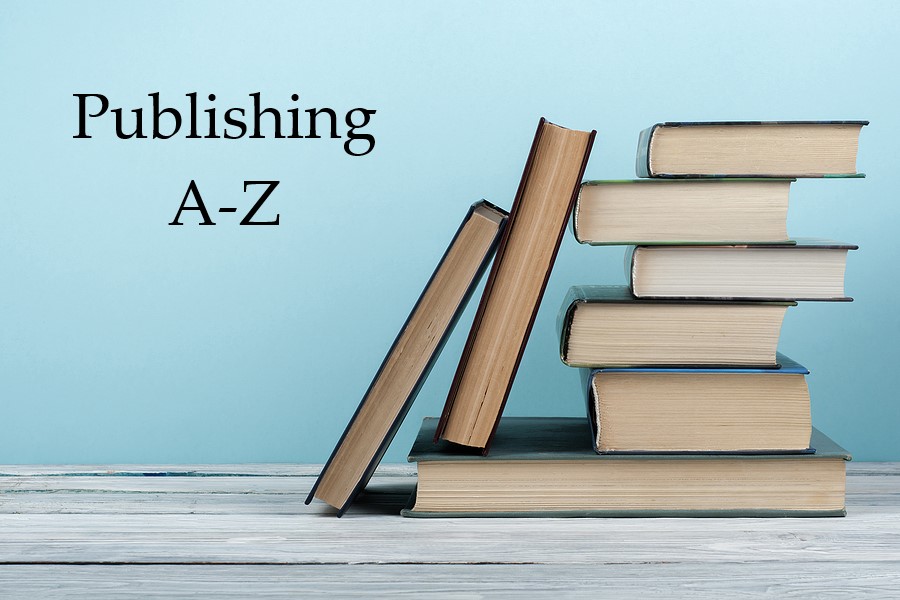When a book is physically printed, there are two, among many, decisions that must be made. One is trim size. This means the size of the book itself (5.5” x 8.5”? or something else?). The other is our topic for today. The binding.
Binding is the process of gathering the printed pages and assembling them together into a book with a cover.
The two most common choices are perfect binding and case-bound binding.
Perfect Binding is also known as a paperback. The pages of the book are glued to the spine of the cover of the book after all four sides of the pages are machine cut to the trim size mentioned earlier. This is the most common binding process in all of book publishing, whether done with a long print run or a one copy print-on-demand printing.
Case-bound Binding is also known as a hardcover. There are several ways to create a hardcover. Most frequently, the pages are glued together before the hard cover is attached. In some high-end processes, the pages are sewn together before the cover is attached. Note that the inside front and back of the book have a page glued to the cover, creating a hinge keeping the book together. Later a dustjacket is folded over the cover. Note that with most printers you must distinguish between a dustjacketed hardcover and a case-bound hardcover. The latter does not have a dustjacket and, instead, the cover is printed on the cover itself. This is becoming more common with textbooks since the dustjacket is fragile and easily torn.
Below are a number of other options that are familiar to most of us, but we don’t necessarily think of them when talking about books.
Saddle Stitch. Some call this “staple-bound.” This is where the book, or booklet, is stapled through the crease in the middle of the folded pages. There isn’t a spine that can be printed with the name of the book. The stapled edge is what’s seen when placed on a shelf. Once your book is longer than 80 printed pages, you may want to consider a perfect binding instead.
Comb Binding. This is often used with cookbooks because the plastic c-shaped spine can be printed with the title of the book. When the book is opened, it can lay flat no matter what page is opened.
Coil Binding. Almost identical to comb binding, this uses a wire coil instead of a plastic coil with a spine. Wire coil binding rarely has a spine unless there is a creative paper cover placed around the entire product.
Lay-flat Binding. Also known as OTA-binding. (OTA is named after the Finland-based company Otavia that patented the process in the early 80s.) In this process, the spine of either a paperback or a hardcover pulls away from the spine of the book and yet the pages still stay together. There is a good picture of this at this link. Some books need this type of process, but it does cost more to apply.
3-Ring Binder. Please don’t laugh, but this is considered a “binding” process, although not one used in commercial book publishing. You may have prepared your pages with a three-hole punch and put it in a binder, so you can easily carry it with you. Many office manuals are compiled this way because it is easy to remove a section and replace it with a new one without reprinting the entire manual.
Next time you have a conversation with a printer about your book, you’ll have a better understanding of your options.




B is for the binding
that holds a book together,
and I am here confiding
that I like Moroccan leather.
It’s a stitching process,
an art form in itself,
and not something one tosses
blandly on the shelf,
but keeps instead quite visible,
that the goatskin grain is seen
and gently touched (so pliable)
and makes the reader keen
to hold the cover ‘gainst his skin,
to breathe deep of what may lie within.
Great, informative article about different formats of book bindings.
TYPO ALERT: In the sentence that begins: All four SIZE…Perhaps it should be read All four sides are cut….
Thanks again fir all your informative articles.
Yes, the 3-Ring Binder Binding is real! We once paid $200 for a Spanish textbook for our running start student and it just came as a pile of pages with 3 holes punched in one end. We had to provide our own 3-ring binder, too!
How many publishers are using print on demand at this point? Obviously it’s the only way to go if you self-publish, but I wonder if traditional publishers take advantage of this option at all.
Thanks and God bless you!